|
|
It’s a short (but
difficult) drive from the Brussels airport to the beautiful Grand Place
square at the city center. Brussels is filled with medieval roads
that run in various confusing directions, so park your car downtown and
walk from place to place. The city’s best new specialty beer bar
has to be the Delirium
Café (4A Impasse de la Fidelite) that boasts more than
2000 different beers from almost 60 different countries. Colorful
old wooden beer barrels form the tables in this delightful cellar pub
near the Grand Place. Delirium owner, Joel Pecheur, is a
dedicated beer lover who has created a café that is also a beer
monument complete with hundreds of beer signs and posters, nostalgic
glasses and trays, and a beer list the size of a small phone
book. Opposite the front door of Delirium Café is the
Jeanneke Pis statue that is a female version of Manneken Pis (a small
sculpture of a urinating boy that is a symbol of Brussels).

Joel Pechur owns Delirium Café
No beer lover should miss Brussels’ Cantillon
Brewery (56 Rue Gheude, Anderlecht) that produces outstanding
examples of spontaneously fermented Lambics. These ales have no
additions of cultured yeasts and rely on the microbes that reside in
the atmosphere around Brussels and in the wooden fermenting barrels to
change the wort into beer. Lambics are usually golden ales that
contain only 3-6% alcohol by volume (abv) and are made with a portion
of unmalted wheat. Cantillon was founded in 1900 and is now a
working museum of brewing - for a small entrance fee visitors can take
the self-guided brewery tour and enjoy samples of the earthy, sour,
intense Lambics. Old Lambic
blended with young is called Gueuze, and there are fruit versions with
cherries (Kriek) and raspberries (Framboise). Jean-Pierre Van Roy
married a daughter of the Cantillon founder and took over brewing
responsibilities in 1978. By refusing to take shortcuts such as
pasteurizing or sweetening his products for the mass market,
John-Pierre has become known as a true Lambic traditionalist and
inspiration for other brewers.
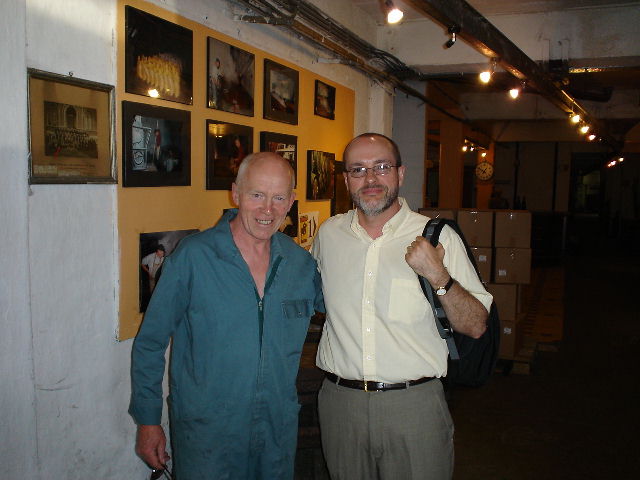
Jean-Pierre Van Roy and Owen Ogletree in the Cantillon
Brewery museum
After a magnificent day of pub crawling in the center of Brussels (see
the list of pubs at the bottom), day two found me driving out to the
more rural, Lambic producing suburbs of Brussels known as
Payottenland. My first stop was the Lindemans Brewery (1479
Lenniksebaan) in the small town of Vlezenbeek. Lindemans is
famous for production of popular, non-traditional fruit Lambics that
are pasteurized and sweetened. Their sweet, dessert-like
Framboise is the biggest seller in the states, and a more acidic
version of an apple Lambic is on the way in early 2006. Dirk
Lindeman, who is the nephew of the owner Renee Lindeman, greeted me at
the brewery and gave a tour of the pint-size, rustic old brewery and
the grand new brewery that was installed in 1992. It took seven
years to gain permission to build the new brewery because the original
facility was started on a farm, and the surrounding area had to be
rezoned from agricultural to industrial. Lindemans (like all
Lambic brewers) only brews in the cooler months of the year (September
to April) to avoid the disruptive wild yeasts of summer that can give
the beer off-flavors. However, summer is busy with bottling,
kegging and blending. Lindemans has a dozen employees and a
production of 3.5 million liters.
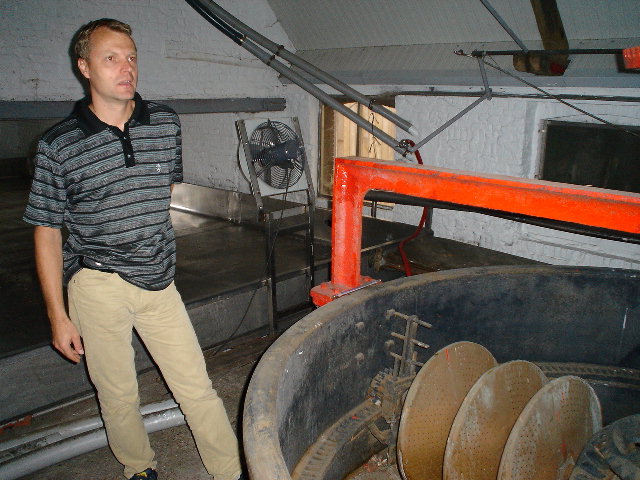
Dirk Lindeman shows off the mash tun in an old portion of
the Lindemans brewery
Next stop was the interesting De Cam
lambic blending facility (67A Dorpsstraat) located in the De Cam Museum
of the town of Gooik. Started in 1997 by a professional brewer
from another company, De Cam attempts to create unique, flavorful and
traditional Lambics by blending select ales from other Lambic breweries
in the region. The manager’s brain is filled with Lambic
trivia. For example, I learned that some of the unmalted wheat
used to make a Lambic produces liquid that goes into the brew kettle
with raw, unconverted starch. This starch is slowly digested over
many weeks/months by unusual (but necessary) microbes (like
Brettanomyces wild yeast) that ferment the brew in later stages.
There is also a friendly café in the museum where visitors are
able to purchase the beers and dine on hearty Flemish cuisine.
A short drive south brought me to the Boon
Brewery (65 Fonteinstraat) in the town of Lembeek. Beer
fans are able to join group tours which begin at the Kring Café
next to the Lembeek church every Wednesday at 3 PM. Frank Boon
purchased the old De Vits Lambic brewery 30 years ago, and everyone
called him crazy. He is now one of the most respected brewers of
this ancient style of beer and produces flavorful examples of Oude
Gueuze and fruit versions (such as his popular Kriek made with 200
grams of real cherries in each bottle and refermented in the bottle
with no added sugar). The term “Oude” on any Lambic label means
that the Lambic is made in the old, traditional fashion and must be
fermented and/or aged in a wooden barrel for at least 18 months.
The Boon brewery is quite traditional - on the day I visited the old
mechanical mash stirrer from the late 1800s was under repair.
Frank told me that recent “hygiene” laws proposed by the European Union
against food or drink being in contact with raw wood were a big concern
to many traditional Lambic producers. But upon learning how
Lambics require wood aging and other ancient methods to be produced,
the E.U. officials eased up and made exceptions. The good news
for Boon Lambic lovers is that Frank’s sons enjoy working in the
brewery and want to take over when Frank retires. Frank said that
at present he has “no plans to retire.”

Frank Boon in front of his prized wooden barrels where
lambic is aged
The best dinner in all of Payottenland can be had at the Drie Fonteinen Lambic brewery
café (2A Hoogstraat) at the center of the quaint town of Beersel
just south of Brussels. Brothers Armand and Guido Debelder run a
Lambic brewery and blending operation along with a fine restaurant that
serves all their noteworthy beers with many elegant dishes prepared
with beer. The excellent bottled Drie Fonteinen Lambics are
available at the café to take home as well.
Day Three. In the morning I force myself out of bed and into the
shower to recover from my Lambic-induced haze and hit the road to the
southeast of Belgium for a visit to the Brewery of the Abbey Notre-Dame at Orval (6823
Villers-devant-Orval, Florenville). This Trappist monastery
produces one dark golden, dry, spicy ale that exhibits noticeable
hoppy, earthy, mineral-like complexity. The term “Trappist” is
shorthand for a Catholic religious order, the Cistercians of the Strict
Observance. Only beers made within the walls of a Trappist abbey
by (or under the direction of) the monks may print the “Trappist”
appellation on the label. A portion of the proceeds from the sale
of the beer must also benefit charity. Orval’s Trappist ale is
made from pale malt,
light caramel malt, hop extract, hop pellets and liquid candy
sugar. The brewery’s general manager is Brother Xavier, and the
other employees are brewing professionals. Dry hopping is done in
huge sacks (like giant tea bags) with Hallertau hops, and the beer has
a bit of yeast and sugar added to the bottle to produce natural
carbonation. The Orval label artwork shows a fish with a ring in
its mouth. A legend says that around 1076 a princess dropped her
wedding ring in a gushing spring and prayed to the Virgin Mary for its
return. After a small trout came to the surface and returned the
ring to the princess, she called the area “aurea vallis” (Orval –
golden valley) and decreed that an abbey would be built there.
Orval has a visitor’s center with walking access to the ruins of the
old abbey. There is also a gift shop where visitors may buy Orval
beer, glasses and the cheese made by the monks. The Ange Gardien brewery café on
the main drive to the abbey offers tasty food, Orval beer and the
monk’s table version of Orval that is lighter in flavor and
alcohol. Visits to the actual brewery are restricted to persons
with connections to the brewing industry.
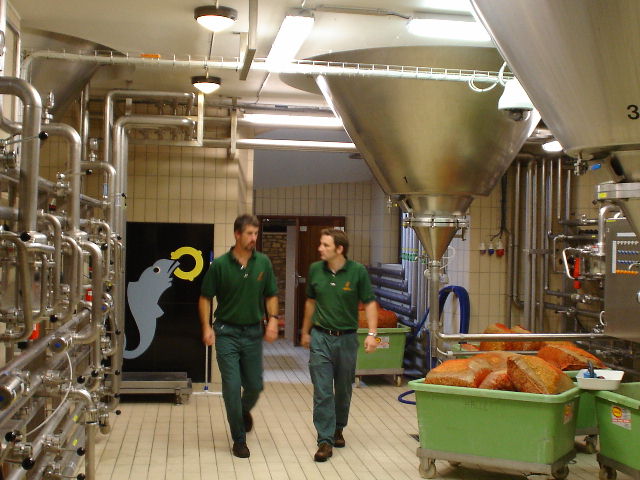 
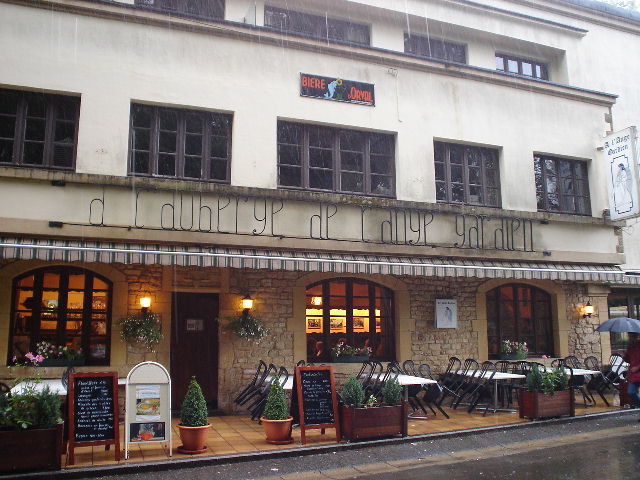
Orval's Ange Gardien
brewery café
About a one hour drive north of Orval is the town of Rochefort.
This is the location of the Rochefort
Trappist Brewery at the Abbey Notre Dame St. Remy (8 Rue de
l’Abbaye). Their Rochefort 8 is a beer of around 9% abv, and the
same beer made stronger with more ingredients is Rochefort 10 at 11%
abv. These ales are rich and flavorful with notes of dark fruit,
chocolate, dark candy sugar, alcohol and spices (although they contain
no spices). As with most Trappist breweries, Rochefort is
cloistered (closed to the public), but I was able to gain permission to
visit the abbey from Rochefort brewery engineer Gumer Santos.
Gumer is not a monk but he has a deep appreciation for the lifestyle
and philosophy of the Trappist way of life. He introduced me to
the monastery’s Father Abbott who makes all the decisions for the
brewery. Father Abbott has been at the abbey for 24 years and
told me, “Monks have been making beer for centuries, and we have that
tradition to uphold. The recipes and yeasts may change a bit over
time but the feeling for the beer and the brewing way of life is the
same. Our first task as monks is not to produce beer but to
search for closeness to God. Work in the brewery is part of our
full spiritual life.” The brothers spend 6-7 hours in church each
day and use the proceeds from the brewery to support the abbey and
local charities. The Abbott also told me that the laypeople who
work in the brewery receive the spirit of the monastic way of life and
have a wonderful working relationship with the brothers. The
Father Abbott was also the person who designed Rochefort’s attractive
new goblet shaped glass. The abbey does not have a café, but
there are many enjoyable bars and restaurants in the town of Rochefort
in which to sample the abbey’s beers.
Rochefort’s brewery only works to about one half of its capacity
because the abbey feels that this is sufficient. Brewing begins
most days at 3:30 AM when Gumer Santos says “there is a magical
atmosphere at the brewery with the sunrise coming through the stained
glass windows.” Gumer trained as a technical brewing engineer for
almost 12 years but has no computer in the brewery – everything is done
by hand with a personal touch. After primary and secondary
fermentation the beer is centrifuged and placed in bottles with sugar
and more of the original yeast for refermentation in the bottle.
The bottles are warm-conditioned for two weeks to allow for carbonation
and then shipped out. The new importer to the USA is Seattle’s
Merchant du Vin who imports around 4000 cases total for a year.
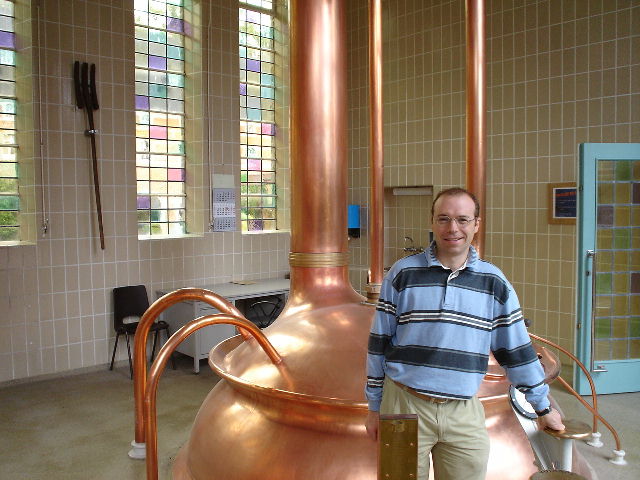
Gumer Santos in the beautiful Rochefort brewhouse
Near Rochefort, in the small hamlet of Falmignoul, I made my way to the
microbrewery called Caracole
(86 Cote Marie-Therese). Known for the cartoonish mollusks on
their labels, Caracole produces flavorful ales that include a spiced
wheat beer, amber ale, strong golden ale, and strong brown ale.
Casual visitors are welcome in the summer months for frequent tours and
sampling.
On my fourth day I was off toward the northern area of Belgium near
Antwerp to Westmalle – home of the Trappist brewery of the Abbey of Our
Beloved Lady of the Sacred Heart. Westmalle is the largest of the
Trappist beer producers and maintains a huge commercial plant at the
abbey that is overseen by monks and completely run by brewing
professionals and laypersons. Westmalle produces a Dubbel (brown
in color with a caramely, spicy flavor and 7% abv) and a world-class
Tripel (golden with 9.5% abv and a deep malty, peppery, citrus fruit
character). Pure groundwater from the abbey, French malts, yeast,
hops (Czech, Russian and German) and candy sugar are the only
ingredients used to make the fine brews. Mini-brews are done each year
with the new malt and hop crop for taste testing and consistency.
120,000 hectoliters are produced each year, and a new state-of-the-art
bottling line was installed in 2001. One technician is in charge of
Westmalle’s large yeast propagation facility. Unpasteurized Dubbel is
sent to a very small kegging room with added yeast to carbonate in the
kegs – the Tripel is no longer kegged. Also, a mild blonde ale
called “Extra” is produced twice a year for limited release and
consumption by the monks. The abbey has existed for 200 years,
and the monks have given up much of the labor of the brewery to
maintain their quiet, contemplative life that is dictated by the Rule
of Saint Benedict (the founder of modern monasticism). The board
of directors is made up entirely of the 22 Westmalle brothers (52 to 92
in age) who take thoughtful time in making every brewery decision - the
website even took two years to work out. The monks have cows and
make their own cheese (brewery spent grains fed to the cows give the
cheese a sweet flavor) which is only available for sale at the abbey
and the Trappisten café
across the street. The attractive Trappisten café also
serves lunch, dinner and the Westmalle beers.

The road to Westmalle
The evening after my visit to Westmalle was spent touring the best beer
bars in the center of Antwerp (see list at bottom of this page).
The highlight of my following day in Antwerp was a visit to the city
brewery De Koninck (291
Mechelsesteenweg). Started in 1833 by the De Koninck family, the
brewery was purchased in 1919 by the Van Den Bogaert family and is now
being run by Dominique Van Den Bogaert, the grandson of the
purchaser. De Koninck produces the world’s most authentic and
drinkable Belgian Pale Ale (5% abv) that is available unpasteurized on
draft all over Antwerp. If you order a “bolleke” at any pub in
the city, you will receive a goblet of De Koninck pale ale; this beer
accounts for 90% of the brewery’s production. The copper colored
ale is similar to an English Pale Ale but is more aromatic in malt and
fruity fermentation notes. Other special brews are produced
including De Koninck Blonde at 6% abv, an 8% abv Tripel and a Winter
Koninck at 6.5%. The brewery sits on land that housed the
Pleasant Garden Pub in 1827 that faced a city park where criminals were
hanged in public executions. Following the gruesome
entertainment, the onlookers went to the pub for a beer. De
Koninck is a compact city brewery with two floors and good use of
limited space. Dominique said “The brewery produces a large
quantity of beer per square inch. Being on a city block, the brewery
has limited space but De Koninck is associated with Antwerp and we take
pride in being in the city.” The old brewhouse (now a museum) was
retired in 1995 and a new, much more modern facility took over next
door.
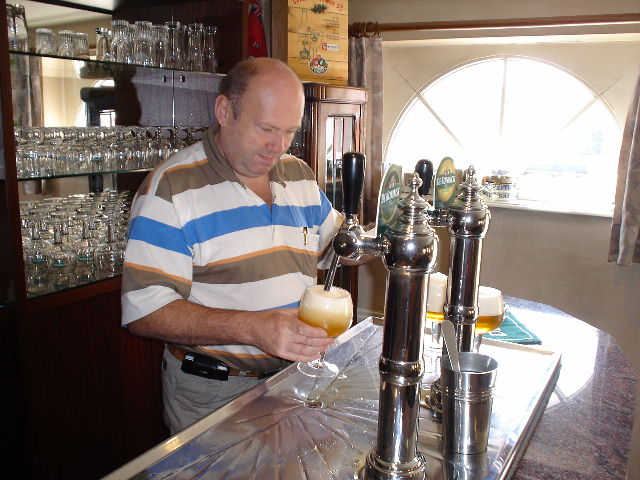
Dominique Van Den Bogaert pours a "bolleke" of De Koninck
ale in the brewery's taproom
Day five led me west from Antwerp to the small brewers’ town of Watou
in West Flanders. There is a statue near the center of town that
pays tribute to Belgian brewers, and Brewery
Van Eecke (2 Douvieweg)
fills the role of local brewery quite nicely. Van Eecke churns
out a line of excellent bottle-conditioned beers including Kapittel
Pater brown ale, Kapittel Dubbel, Kapittel Prior Strong Dark Ale,
Kapittel Abt Tripel and the golden, refreshing, yet hoppy and complex
Hommelbier. Brewery tours are available on Tuesday, Wednesday,
and Saturday. Next door to the brewery the café In Het Brouwershof serves the full
range of the Van Eecke beers.
Across the town square from Van Eecke in Watou sits the amazing Hommelhof restaurant (17
Watouplein). Watou is in the middle of the hop growing region of
Belgium. Hommelhof actually means “hop court” in Flemish, and
this café specializes in scrumptious food prepared with Belgian
beers. Chef/owner Stefaan Couttenye recommends the section of the
menu called “Het land van Amen” where each course is cooked with and
served with a beer. Examples include tomatoes and caviar with
Rodenbach red ale, sole with mushrooms and Hommelbier, veal with
coriander and St. Bernardus ale, and Flemish biertarts with Kriek
Lambic. There are 30 or so good beers on the menu, but even don’t
think of coming here to drink without eating – it would be such a
waste.
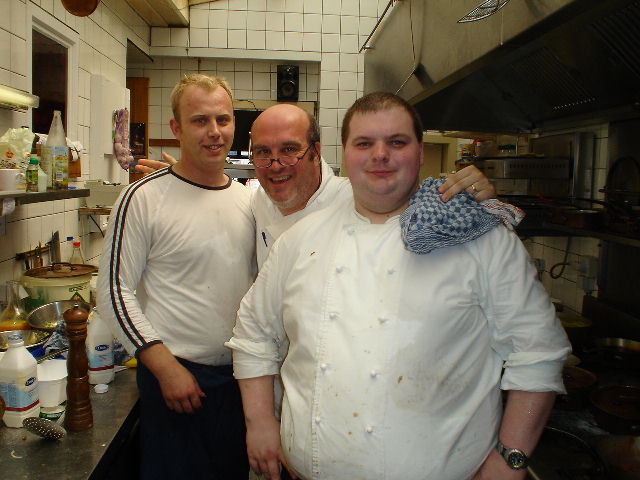 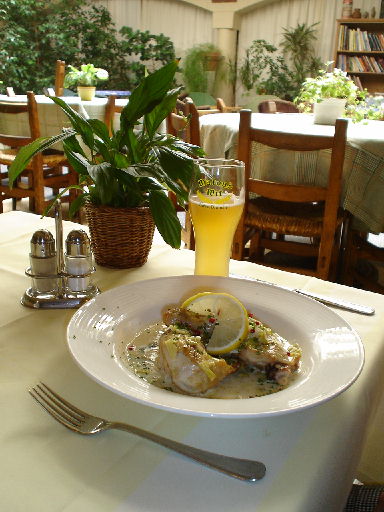
Hommelhof chefs Thiery, Stefan and David
Day six. I drove down a diminutive road (more like a paved cow
path) from Watou to Westvleteren to check in to the delightful
Pahilleke bed and breakfast run by my friends Patrick and Hilde
Gouwy-Hauspie. There is a walking path behind the B&B that
leads to the Saint Sixtus Trappist Abbey that is the location of the Westvleteren brewery (12
Donkerstraat). The three admirable beers that are produced here
include a Blond ale (a spicy pale ale at 6% abv), Westvleteren 8 (a
brown Dubbel-type ale at 8% with hints of raisins, licorice, and cocoa)
and Westvleteren 12 (a 10.2% Belgian Strong Dark Ale with remarkable
layers of dark fruit, chocolate, and spice notes). The
Westvleteren beers are produced in very small quantities are are only
available for sale at the small drive-up sales window of the abbey and
at the Vrede café across the street. There is a limit of
five cases of beer per vehicle, and everyone who purchases the beer
agrees not to resell it. The beers have no labels – only the
color-coded bottle caps have printed information.
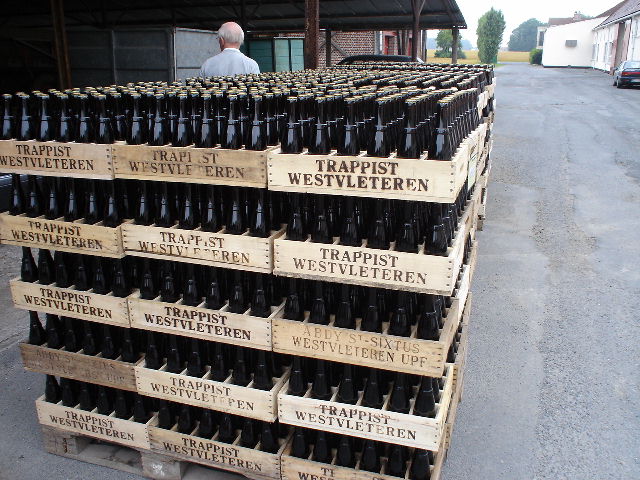
Bottles of Westvleteren 12 sit ready to be delivered
across the street to In
De Vrede café
I was invited for a rare visit to the abbey to interview Brother Joris
who is in charge of the brewery. He was quick to express to me
his concern over the Westvleteren beers being resold in America by
persons who are shipping them over and adding their own labels.
Joris told me “We decided in the 1950s to have a small brewery and
limit production so we can do most of the work.” Unlike other
Trappist breweries, Westvleteren only employs three workers who are not
members of the abbey. The brothers want their beers to be
available in the area of West Flanders for local, private
consumption. Persons buying the beers for resale in other areas
cause the products to sell out too quickly at the abbey. Joris
says “We brew to live, but don’t live to brew. We want to be a
local brewery and produce enough beer to support ourselves and our
endeavors – and no more. We need time for our spiritual
lives.” The annual production of 60,000 crates (each wooden crate
holds 24 bottles) a year is done in 75 days by five of the 27 members
of the monastery. The bottling line dates from 1978, runs only 35
days a year and can fill 12,000 bottles an hour. The monks have
no desire to increase production, and they admit that rarity and
exclusivity of their beers contribute to a mystical aura.
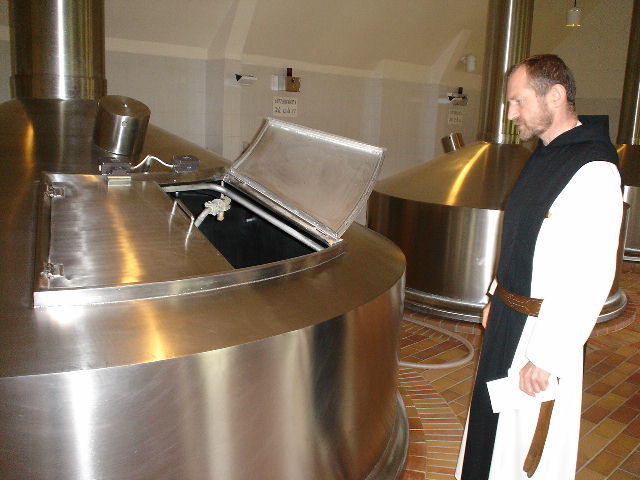
Brother Joris in the Westvleteren brewhouse
The Westvleteren beers are produced in open fermenters and contain
water, malts, sugar, and hop pellets and hop extract only. There
are no spices in the beer, and Joris says “the specific list of malts
and ingredients in the 8 and 12 is classified.” The 8 and 12 are
different strength versions of the same recipe. There are two
brew kettles at St. Sixtus abbey, and the stronger first running of a
mash can go into one kettle to become the 12 while the weaker, later
mash liquid goes to the second kettle to make the 8.
Westvleteren’s yeast comes from Westmalle, and a brewery worker drives
to Westmalle to pick up fresh yeast for each batch. The same
yeast is used to ferment the ales and bottle condition the beers.
Candy sugar is used in the 8 and the 12 to boost complexity and
alcohol, but there is no sugar added to the Blond. Monks are
allowed to drink the Blond beer with their meals (which are
vegetarian).
Westvleteren is the smallest and most private of all the Trappist
breweries, but across the street from the abbey is the not-to-be-missed
In De Vrede (“In the
Peace”) café that welcomes the public. A much larger
café with outside patios replaced its tiny roadside predecessor
in 1999 and was built a few more meters away from the abbey to help
accommodate the crowd of visitors and keep the noise away from the
monks. The café is owned by the abbey and leased to a
manager. The small menu consists only of soup, cheese, cheese
sandwiches and the three marvelous Westvleteren beers. The cheese
comes from French abbeys just over the border. There is a gift
shop selling the Westvleteren beers and other souvenirs of the area,
and De Vrede also has a multi-media museum (The Claustrum) with displays (mostly
in Dutch) that explain the philosophy, lives, and history of the monks
of St. Sixtus abbey. The Claustrum is only open from 2-5 PM and
closed on Fridays.
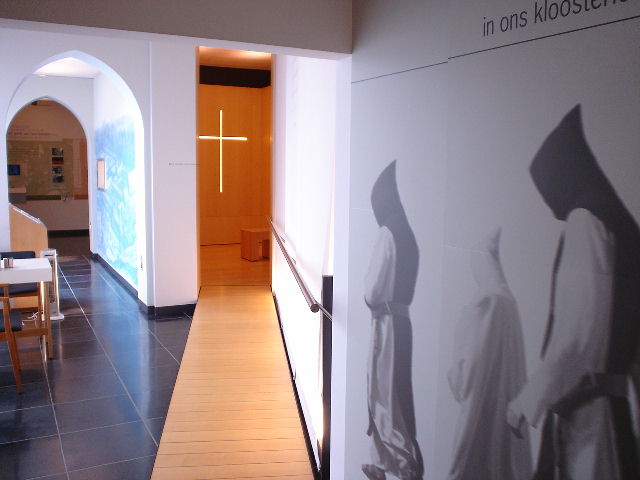
The Claustrum exhibit at In De Vrede
Driving from Westvleteren back to Brussels on the seventh day of my
Belgian experience took me to the busy town of Roeselare. I had
phoned ahead to visit the Rodenbach
brewery (133 Spanjestraat), and brewery manager Rudi Ghequire showed me
around the old, unused brewery that dates from 1836 and also the
sparkling, new, highly automated brewery that was put into operation in
2004. Amazingly enough, both breweries were designed and built by
the same company 168 years apart! Rodenbach has been absent from
the U.S. market for the past few years due to its purchase by Palm
Breweries in 1998 and the switchover to the new brewing facility.
Rudi told me that Ommegang in New York is now importing the Rodenbach
beers into America, and this fall we should see the classic Rodenbach
and the Grand Cru back on shelves here. Both these beers start
with a low alcohol, lightly hopped red ale that is primarily fermented
in stainless steel tanks and then transferred to old, impressive,
closed-top wooden vats where the beer takes on a luscious vinous, sour,
fruity character after two years. Rodenbach employs a “mixed”
fermentation of ale yeast with wild yeasts and bacteria that reside in
the wood. Beers from several of the wooden vats are blended for
consistency, and this complex ale is either bottled as Grand Cru or
added to the young red ale to make the regular Rodenbach. The
company is also bringing forth RedBach - a new beer with a big addition
of cherry juice for an intense, but well-balanced fruit flavor.

The automated device that blends old and new Rodenbach
beers
The Rodenbach brewery complex now houses a gorgeous tasting room and
brewing museum with displays and exhibits that include an old steam
kettle and malt kiln that have sound and light effects. The
museum is open in the summer for groups and receives over 20,000
visitors per year. The brewery also still houses a cooperage to
maintain the wooden fermenters. Grass reeds are placed between
the boards in the wooden vessels to help seal the gaps when the vessels
are filled with liquid. The newer vessels are then inoculated
with the strains of yeast and bacteria that help create the complex
Rodenbach beers. Rudi Ghequire has worked for Rodenbach for many
years and he stated to me “Palm Breweries has given us new
possibilities and has not changed the Rodenbach beer. We are
still making real Rodenbach in the way it has always been made, and we
can now guarantee volume in bottles and kegs.”
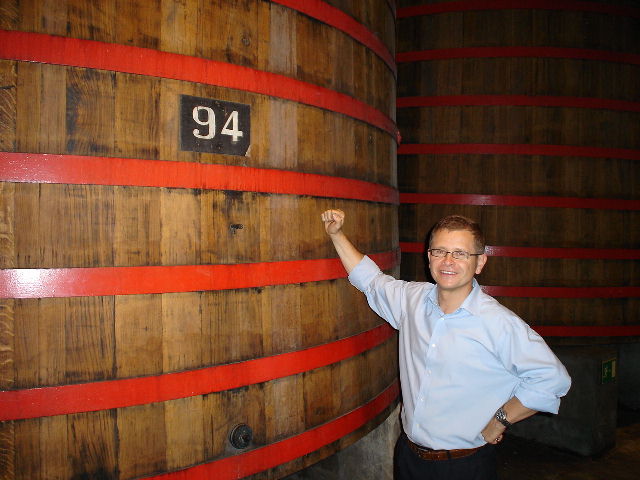
Rudi Ghequire in front of one of Rodenbach's magnificent
wooden fermentation vessels
My thoughts on Day 8 on the plane to Atlanta: It’s easy to see why
Belgian ales fascinate me. But sales of these ancient and unique
beers are on the decline, and bland pilsners and lager beers hold the
majority of the beer market in Belgium. I hope that everyone who
reads this will one day fall in love with the great beers of Belgium,
spread the love to friends and make a trip to Belgium to experience
these wonderful beverages that deserve to be appreciated and preserved.
TIP: No beer lover should head
to Belgium without a copy of CAMRA’s Good
Beer Guide to Belgium written by Tim Webb.
SOME OF BRUSSELS’
BEST BEER BARS & CAFÉS:
- Bier Circus,
57 Rue de l’Enseignement – Beloved beer bar with a huge
selection. A bit of a walk from the Grand Place but worth it.
- La Becasse, 11
Rue Tabora – Timmerman’s Lambic café with tasty bread, soft
cheese and radish appetizer.
- Brasseurs, 24
Rue de la Colline (Grand Place) – Big brewpub with mild house beers
including a lager, English ale, Wit, cherry beer, dark ale and a
bottled Tripel. Fish, steak, chicken and various desserts.
- Delerium Café,
4A Impasse de la Fidelite.
- La Villette, 3
Rue de Vieux Marche aux Grains – Tiny restaurant that spills out into
the big street plaza out front. Cuisine made with beer.
- Mort Subite, 7
Rue Montagnes aux Herbes Potageres – Gorgeous 1920s café with
mass-market, sweet Mort Subite Lambics.
- Paon Royal, 6
Rue du Vieux Marche aux Grains.
- Poechenellekelder,
5 Rue du Chene – Puppet-filled pub near the famous Manneken Pis statue.
- La Rose Blanche,
11 Grand Place – The “White Rose” is a friendly restaurant that
overlooks the Grand Place. Try the fixed price, three course beer
dinner.
- Spinnekopke, 1
Place du Jardin aux Fleurs – The “Little Spider” has Cantillon Lambics
for an aperitif and superb beer cuisine (even desserts made with beer).
- Toone, 6
Impasse Schuddevelde – Near the Toone Puppet Theater.
- Zageman, 116
Rue de Laeken – Personable old bar with fine Lambic and Gueuze.
SOME OF ANTWERP’S
BEST BEER BARS & CAFÉS:
- Berenbak, 17
Minderbroedersstraat - Small pub next to the school of fine arts.
- Den Engel,
Brabo Square Antwerp Centrum – Oldest and most popular pub for a De
Koninck ale. Overlooks the famous Brabo “hand-thrower” statue and
fountain.
- Groote Witte Arend,
18 Reyndersstraat – Courtyard bar with some good Lambics.
- Highlander, 2
Pieter van Hobokenstraat – Scottish pub with a variety of beers and
single malts.
- Kulminator, 32
Vleminckveld – Best beer selection in Antwerp that even includes
vintage ales from previous years.
- Oud Arsenaal,
4 Maria Pijpelincxstraat - After a beer here go across the street to
the Horta restaurant for great food.
- Paters’ Vaetje,
1 Blauwmoezelstraat – The name means “monk’s coffin.”
- Pakhuis, 76
Vlaamse Kaai – Take a taxi down to this warehouse brewpub. Try
the Blonde ale with soup, the Antwerp Brown with an entrée and
the “Scary” Tripel with the ice cream beer dessert.
- Waagstuk, 20
Stadswaag – Beautiful old café with respectable beer list.

Brabo statue and fountain in the Antwerp Central Square
|




















